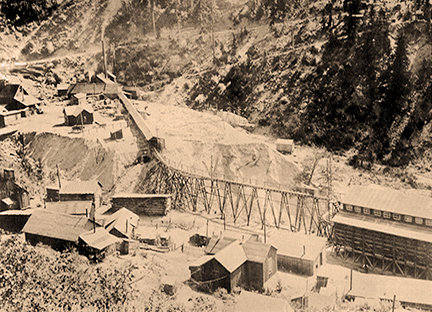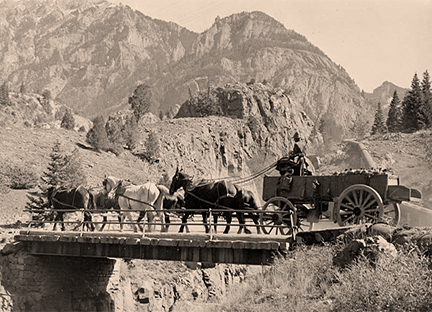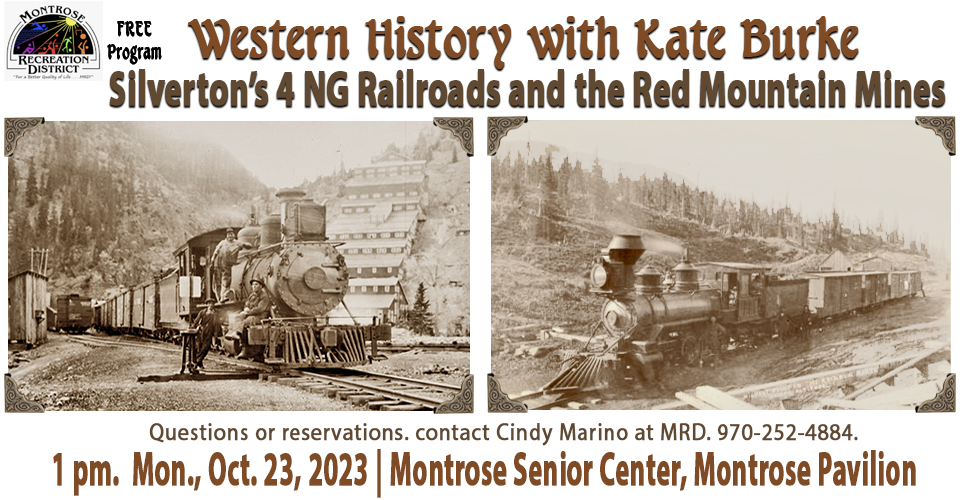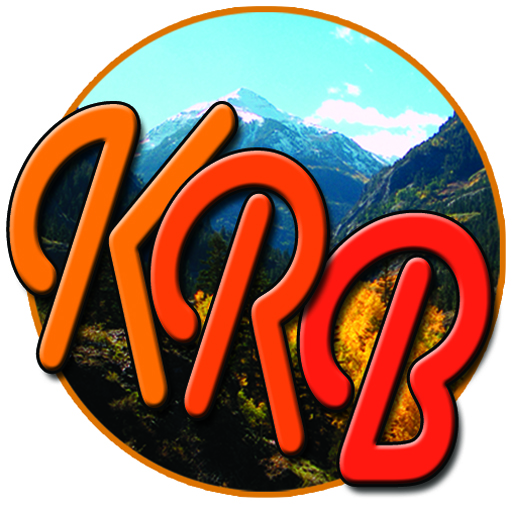Gold! And the gold mine that saved the town of Ouray

Bachelor Mine Complex. Courtesy Ouray County Historical Society. Ca 1888. This image appears in the book, Tales of the Bachelor Mine by Jane Bennett, published by San Juan Publishing Group.

Highgrade ore from the Camp Bird mine being hauled by wagon to Ouray. The mine had produced over a million ounces of gold by 1916. Credit: Western Mining History.com
[Montrose Mirror | September 4, 2023 | By Kathryn R. Burke]
Gold! Just the sound of the word inspired (and still inspires) Gold Fever. Which inevitably led to a…Gold Rush. At a time when the world’s money supply was based on gold, the mineral provided economic stimulus far beyond the goldfields, feeding into local and wider economic booms. Gold Rushes helped spur waves of immigration that often led to the permanent settlement of new regions. Activities propelled by gold rushes define significant aspects of the culture of the North American Frontiers. Historians have written extensively about the mass migration, trade, colonization, and environmental history associated with gold rushes. (1)
Historic Gold Rushes
While we all know about the digging for gold in the San Juans, and the settlements that followed, we were neither the first nor the last place to attract hordes of hopeful gold hunters.
The first significant gold rush in the United States was near Charlotte, North Carolina in 1799, and it was responsible for setting the gold standard for our currency. A young boy playing in the river discovered a chunk of gold about the size of a shoe that wayed 17 pounds. A few years later, his father, John Reed, developed placer mining, then underground mining on the river and founded Reed’s Gold Mine. Reed, and others also successfully mining for gold, became wealthy and began to use gold as currency. To stabilize the country’s economy, President Andrew Jackson authorized the creation of the U.S. Mint. The Charlotte Mint was the first facility, and the Reed Gold Mine, the first gold mine in the country, became a National Historic Landmark. (2)
Thirty years later, gold was discovered in Georgia, in the southern Appalachian Mountains. It was reported that the boomtown gold camps in the area supported 15,000 miners at its peak. The Philadelphia Mint received $1,098,900 in gold from Georgia between 1830 and 1837. When the veins petered out around 1840, boomtowns went bust and miners headed west. (3)
Gold was discovered in the Sierra Nevadas in 1848, leading to the California Gold Rush, which lasted until 1855. Miners were followed by waves of settlers, who quickly populated the area. In 1850, California became the 31st state in the union. As more gold was found, and people were willing to brave the often unfriendly and uninhabitable areas of the west, gold hunters headed for British Columbia, Nevada, Idaho, Montana, eastern Oregon, western New Mexico Territory, Arizona, the Rocky Mountains in Colorado, and Alaska, where the last great gold rush, the Klondike Gold Rush took place in 1896-1899. The most successful North American Gold Rush was the Porcupine Gold Rush in Ontario, Canada. Peaking in the 1940s and1950s, and still active today, gold deposits at that mine are one of the largest in the world. (1)
In Colorado, deposits of gold and silver were discovered in 1860 along the Animas River, when Charles Baker and several other prospectors searched for the precious metals. May prospectors left during the Civil War and did not return to the area until the early 1870’s. The fact that the discoveries were on Ute Indian land, and the San Juans were mostly unhabitable in winter, did not stop an influx of prospectors. Baker and his party went on to found Baker’s Park, now Silverton, in San Juan County. Historians estimate the area’s total production, through 1959 when the last mine closed, was between 874,000 and 1 million ounces. (4)
Ouray
Prospector’s first arrived in the Ouray area in 1861 and discovered placer gold in the canyon that would later be the site of the town of Ouray. Because of the isolation and ruggedness of the San Juan Mountains, combined with the ever-present danger of conflicts with the Ute tribes, the region developed slowly. The first gold mines were established at the Ouray site in 1875, and the initial settlement and mining district was named “Uncompahgre.” Several gold veins were established in the area with the most notable being the Una and Gertrude discovered in the Imogen Basin by George Barber and William Weston in 1877. At its height the region boasted 30 active mines. Gold fever had attracted thousands of miners, who were followed by families and support businesses. (6)
The Town of Ouray was incorporated in 1876. By the early 1880s, Ouray had established itself as the second most prominent town in the San Juan region, behind Silverton. By 1890, when the Denver and Rio Grande Western Railroad reached Ouray, the town had over 2,500 residents. Both towns have many historic buildings remaining from the 1880s because they were built of brick and stone, rather than wood, thus avoiding the catastrophic fires that destroyed so many mining towns. Both communities also had volunteer fire departments. (Annual 4th of July contests between the fire departments is still prevalent today.) (6)
Gold came first, then silver, but it was gold that kept the town going. The Bachelor Mine, on Gold Hill in the Paquin Mining District (just north of Ouray, above Dexter Creek) was established in 1884 by Charlie Armstrong, a prospector, and George Hurlburt, a surveyor. Their friend, J. Frank Sanders, a speculator, bought in. The three men loved a good time and were known to bet on almost anything—even which raindrop would be the first to make it to the bottom of a windowpane. Sander’s gamble paid off when the gold mine also hit a huge silver vein.
For nearly a century, the Bachelor was one of the region’s strongest and most reliable producers. During its heyday, ore worth $200 to $500 a ton shipped out from the Bachelor Switch, a railroad siding below the mine. A town called Ash sprang up near the main portal. It got its name from the first letters of the last names of the original owners: Armstrong, Sanders, and Hurlburt. Ash is gone now, but the town’s remains can still be seen along Red Canyon Creek, now called Dexter Creek. (7)
Boom to Bust, the Silver Panic of 1893
Gold remained the currency basis until the Bland-Alison Act of 1878, which established silver as the standard basis. This was good for Colorado, where silver production through the 1880s remained steady at above 10 million ounces. The state’s gold production was only one third as valuable (or less). (8)
The mine-owners’ requests backfired. Colorado’s mines were going strong, but the nation was on the brink of economic collapse, partly due to the draining of gold in the US treasurer from the Silver Purchase Act, compounded by years of agricultural depression (partly caused by the McKinley Tariff act that same year, 1890, which drove up prices for farm equipment and decreased prices for agricultural products). (9) Seeking to stimulate the national economy, President Grover Cleveland and Congress repealed the Sherman Silver Purchase Act in October 1893, causing what became known as the Silver Panic of 1893. Overnight, the value of silver dropped by about one-third. (8)
The repeal devastated Colorado. Altogether, more than 9,500 jobs dried up in mining towns across the state. The Panic of 1893 produced the worst economic depression in US history to that point. The effects of the economic depression caused by the Panic of 1893 did not fade until 1897. (8)
Gold Saved Ouray
Like many prosperous mining cities in Colorado, Ouray hit hard times after the repeal of the Sherman Silver Purchase Act. Several prominent businesses closed, including the Bank of Ouray. Many men were out of work as many of the local silver mines halted production.
But mining for gold continued and Ouray survived largely because of it. Although gold had first been discovered north of Ouray, those veins had mostly dried up. The Yankee Girl Mine, south of town, was one of the earliest gold mines established in Ouray. The mine was very productive producing over $8 million worth of gold. (9)
Meanwhile, large quantities of gold had been discovered in the Paquin Mining District northeast of town. The area became known as the “Gold Belt.” (11) (Also the name of an infamous bar and bordello in town.) Thanks to mines like the American Nettie, Bachelor, and Wedge mines, by 1895, Ouray began to recover. Many silver mines in nearby districts had some gold content, helping them operate profitably even when silver prices were low. (6)
It also helped that two of the richest mines in the West were nearby: the Revenue and Camp Bird. These mines employed hundreds of men each and kept Ouray humming as a supply center and rail hub for the mountain operations.
In 1897, Walsh acquired the Una and Gertrude Veins and later established the Camp Bird Mine. It was soon turning out $5,000 a day (equivalent to $176,000 in 2022). Wash built a twenty-stamp mill for the mine and donated over $30,000 for the construction of the new City Hall and Library building. He also built a library in Silverton and bought the Hope Diamond for his daughter, now part of a collection at the Smithsonian. Walsh sold the mine to the Camp Bird Limited in 1902. The Mine had produced over a million ounces of gold by 1916. (6)
By 1900, Ouray’s population had been reduced to 2,196 residents. While this figure reflected some of the economic hard times related to the decline in the silver industry, the reduction in population was far less than seen in mining towns of other districts. (10)
Gold saved Ouray. Its economy did not depend on silver, so it continued to prosper.
In the 1920s, a new tunnel at the Bachelor mine, financed by investors from Syracuse, N.Y., was driven to access the Bachelor’s old workings from below. Dubbed the Syracuse, the Mine was renamed the Bachelor Syracuse. It is that tunnel that is open to mine tour visitors, who can take a tour today 1,500 feet into Gold Mountain. (7)
The Bachelor Syracuse Mine Tour looks and feels like the real thing— because it is the real thing. Open May 26 through October 10. For more information, or to book a tour, visit the website, https://bachelorsyracusemine.com/tours/tour-infomation/
References
(1) Gold Rush
https://en.wikipedia.org/wiki/Gold_rush
(2) Reed’s Gold Mine, North Carolina
https://en.wikipedia.org/wiki/Reed_Gold_Mine
(3) Georgia Gold Rush
https://en.wikipedia.org/wiki/Georgia_Gold_Rush
(4) Baker’s Park and San Juan County Gold Production
https://westernmininghistory.com/library/77/page1/
(5) Gold Mining in Ouray, Colorado
https://www.goldrushnuggets.com/gomiinouco.html
(6) Gold Mining in Ouray
https://westernmininghistory.com/towns/colorado/ouray/
(7) Bachelor Syracuse Mine
https://bachelorsyracusemine.com/about-us/
(8) Silver Panic of 1893
https://coloradoencyclopedia.org/article/panic-1893
(9) McKinley Tariff Act of 1890
https://en.wikipedia.org/wiki/McKinley_Tariff#
(10) Gold Mining in Ouray Colorado
https://www.goldrushnuggets.com/gomiinouco.html
(11) The Bachelor Syracuse Mine in Ouray, Colorado
https://xpopress.com/news/article/341/the-bachelor-syracuse-mine-in-ouray-colorado
(12) Colorado Mining Scenes
https://westernmininghistory.com/2683/incredible-colorado-mining-scenes/


